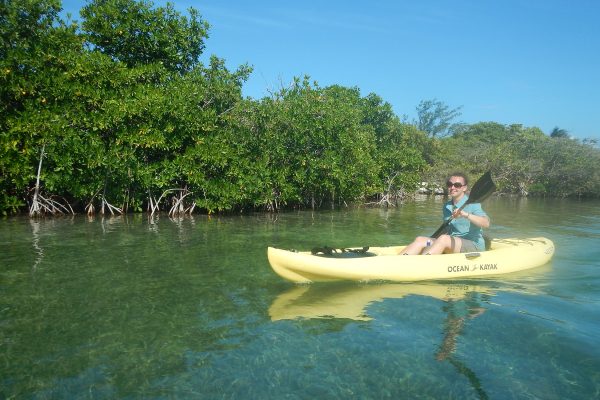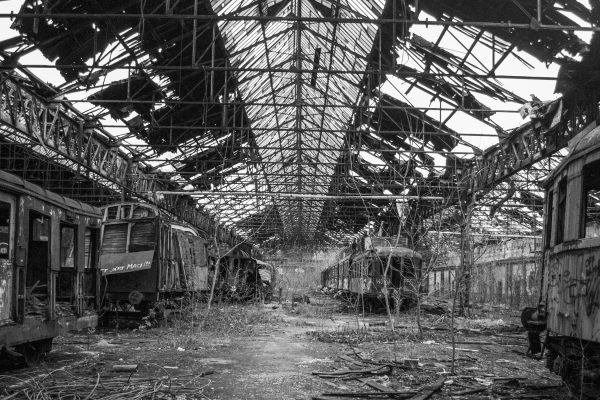Trip duration: 4 days | Approx cost: £300 | When: Spring
Doinit factor: A great introduction to high altitude, surreal views, oh and it’s a live volcano!
The Island of Tenerife attracts hordes of tourists looking for an inexpensive sunny getaway. The package holiday machine ensures that by day the sun is soaked in by the pool and by night the inexpensive nightlife is taken full advantage of. However for a hiker Tenerife can to be a true gem of a destination as the island is home to some of the most beautiful and natural scenery around, all available on a tidy budget. Best known, the centrally located Teide National Park, is home to Pico del Teide. With its summit of 3718 metres above sea level, Pico del Teide is the world’s third highest active volcano (measured from the sea bed) and also Spain’s highest peak.
Though still active, Teide’s last eruption of 1909 has faded from memory and the volcanic cone is now a major tourist attraction. Most visitors will make their way up Teide via the precariously dangling cable car, which for 25 Euros will whisk you to the top viewing platform within eight or so minutes and back down again once you’ve had your fill. Visitors are free to go for a little wander around the main ‘cone’ which almost symmetrically towers up a further 200 meters to the true summit. A summit that is restricted to all but those with an advance permit from the authorities. Hiring a car is a practical solution for those who wish to explore the island and pretty much a necessity if you’re planning on climbing Teide. Public transport links are sparse and links to the starting point are non-existent. The main TF-21 road passes through the national park and is where the trek to the summit begins. Approximately 2km down the road from where the cable car and visitor centre is located, is a small layby were hikers start their journey along the official route (Route Number 7). As this is a protected area you’re reminded by official notices that it’s prohibited to stray from the designated trail and warned not to undertake the strenuous hike if you hold any heart or respiratory problems. The trek itself starts at an altitude of 2100m, well above anything in the UK. Even at this relatively low altitude, the effects of the thin air pressure are visible on air tight products, an effect that many will experience when opening a packet of crisps on a flight.
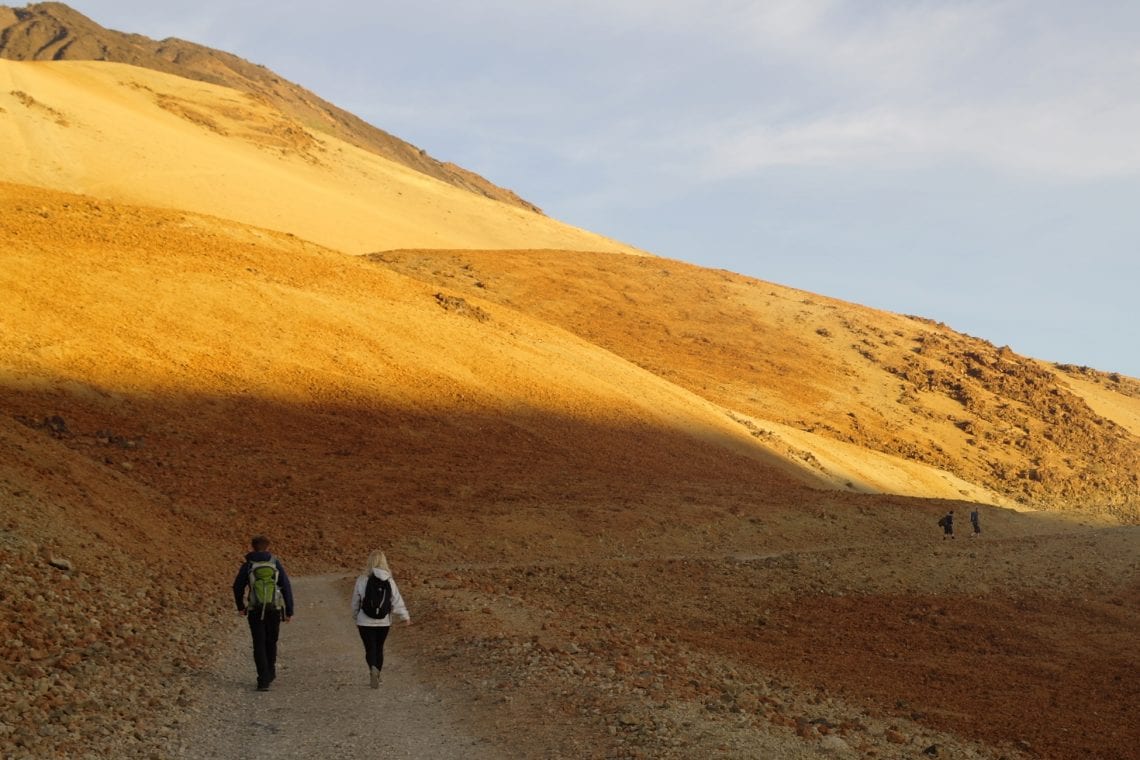
Above: The initial part of the trail gradually winds through the moonlike landscape
Our team of nine set off in the early morning to avoid the mid-day heat and head along the gentle and gradually winding gravel track known as the Montana Blanca, a surreal but beautiful hike on a Mars like landscape consisting of orange dry rock and rolling hills which run for a few kilometres. As the sun rises and the moon begins to disappear the shades of reds and oranges really do make you feel like you’re on another world. The temperatures begin to rise, but still the morning air is refreshing rather than too hot or cold. Teide’s towering peak becomes visible but seems like a mere speck amongst the surrounding horseshoe of mountains. The solidified lava flows that have scared the landscape and the ‘Teide Eggs’ offer an unfamiliar glimpse of a catastrophic eruption that happened over a century ago. The huge, dark boulders scatter the slopes and you can’t help but think of the sheer scale of not only the eruption but the forces that Mother Nature can unleash in order to shift such enormous rocks. The gradual track continues for approximately 4km and can be considered an enjoyable walk, compared to what’s to come. As we walk, only the sound is of our footsteps landing on the gravel, breaking the silence as we press on. Surprised by the stillness of air, it is easy to imagine we’re in the vacuum of space. We take a moment to just stand and admire the eerie atmosphere in complete silence, overlooking the very edges of Tenerife and the sleeping tourist towns. Every step we take brings us to our ultimate goal and the ascent becomes more and more justifiable with spectacular views. Before we continue, we refuel ourselves for what we know will be a long day. Even as we rest here for approximately 30minutes we remain the only people in sight and begin to wonder whether Teide National Park is truly living up to its reputation as one of the World’s busiest.

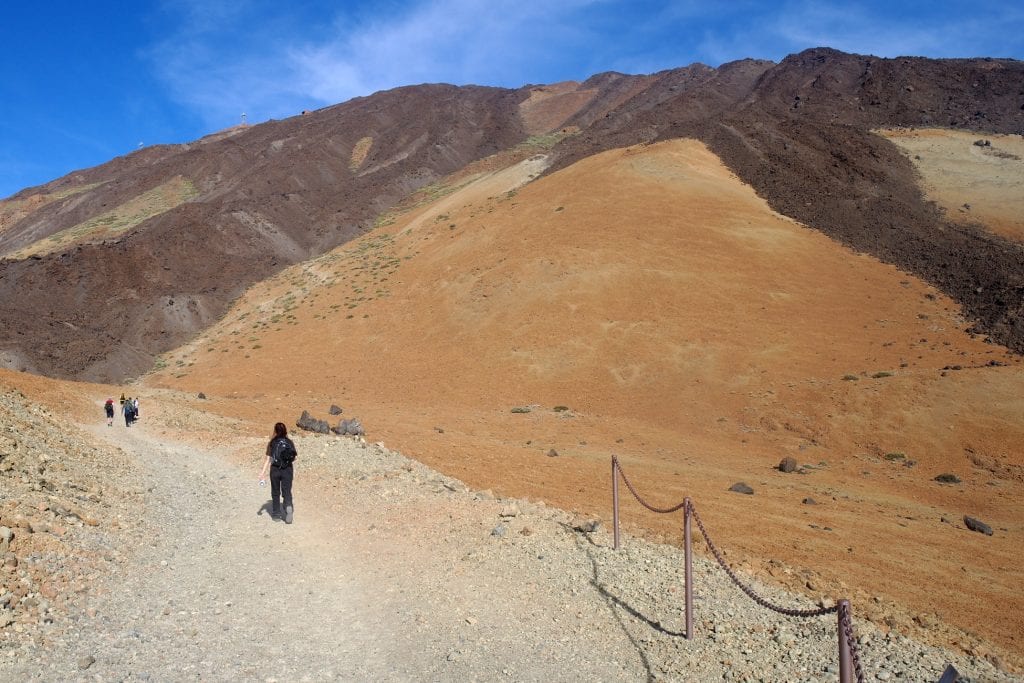
Above: It feels like we have the national park to ourselves as be past cooled lava flows
The fairly easy going section eventually comes to an end and it’s time for the steep and arduous climb. The route begins to play tricks on you as it turns back on itself, like a snake slithering along from side to side. The summit is no longer visible and instead the immediate view is limited to the gradient before us. Altitude is gained in little distance, but with no clear goalposts in sight, progress is slow. As if straight out the textbook, we reach a height of just under 3000 metres and there is a noticeable difference in air pressure. With every step we take, it begins to dawn on us how much of the volcano we have to go, only reaching approximately half of the climbing attitude. Effects of the lower air pressure start to physically manifest themselves in our team as it becomes harder to breathe. A constant shortness of breathe is not helped by the fact we’re physically exerting ourselves in a panic over making our allocated summit climbing time. The only respite we have is that our backpacks are going down in weight with every bite of food and drink of water. Surprisingly, as we continue progressing, despite the drop in air pressure, we can’t help but notice the living environment. Lizards upon lizard chase each other through lava rock and a flurry of insects, mainly consisting of bees can be heard through the dry bushy vegetation; the latter of which proving an unwelcome accomplice on what is already a challenging trek but alas, with the Altavista Refuge (3260m) falling into sight and with something to work towards, progress seems to speed up once again. Here the first signs of human activity appear.
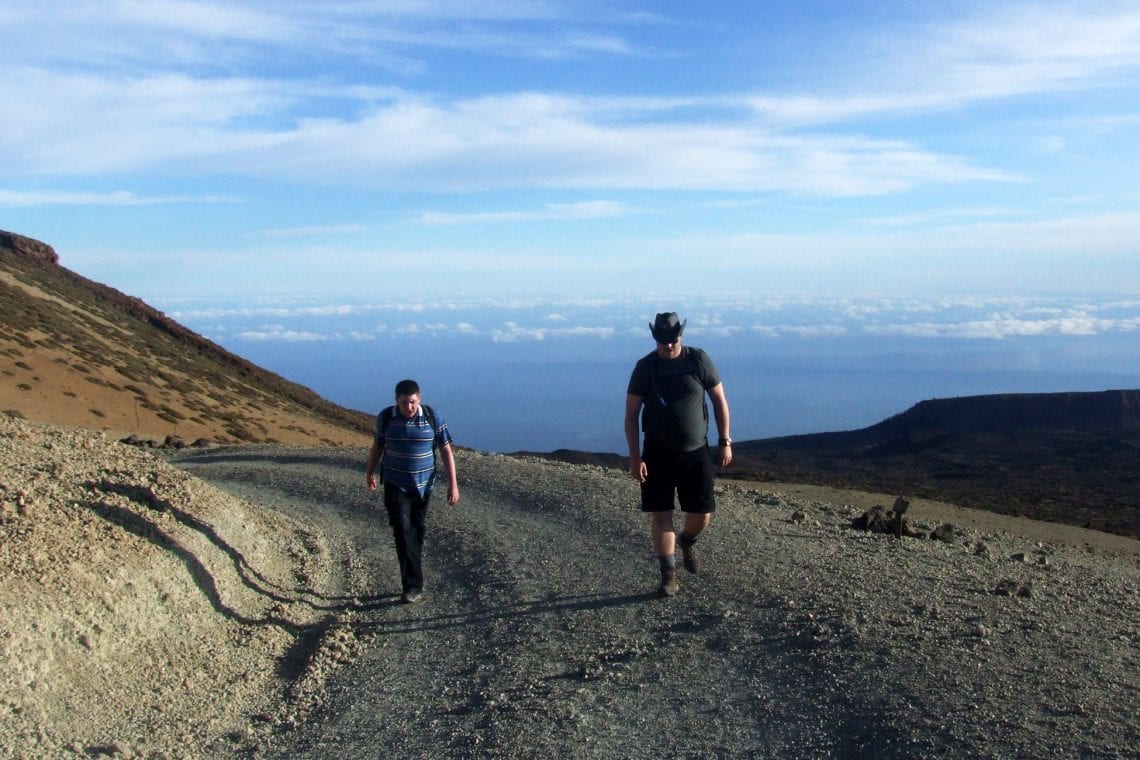
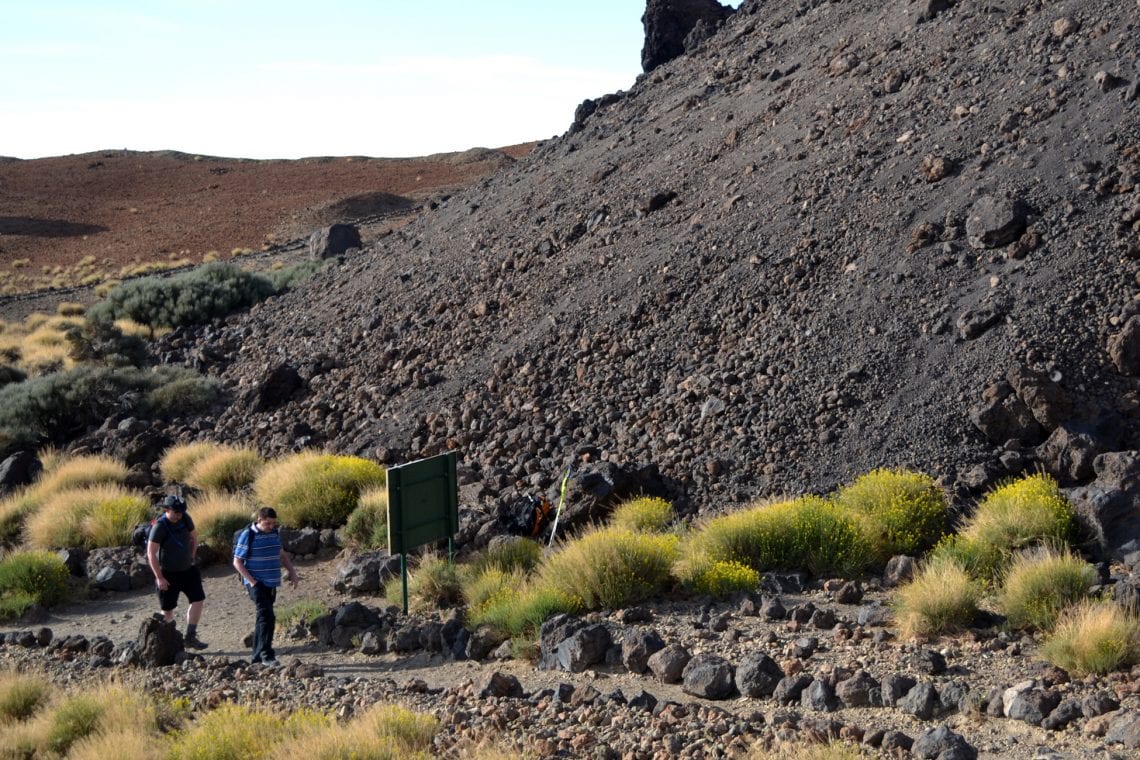
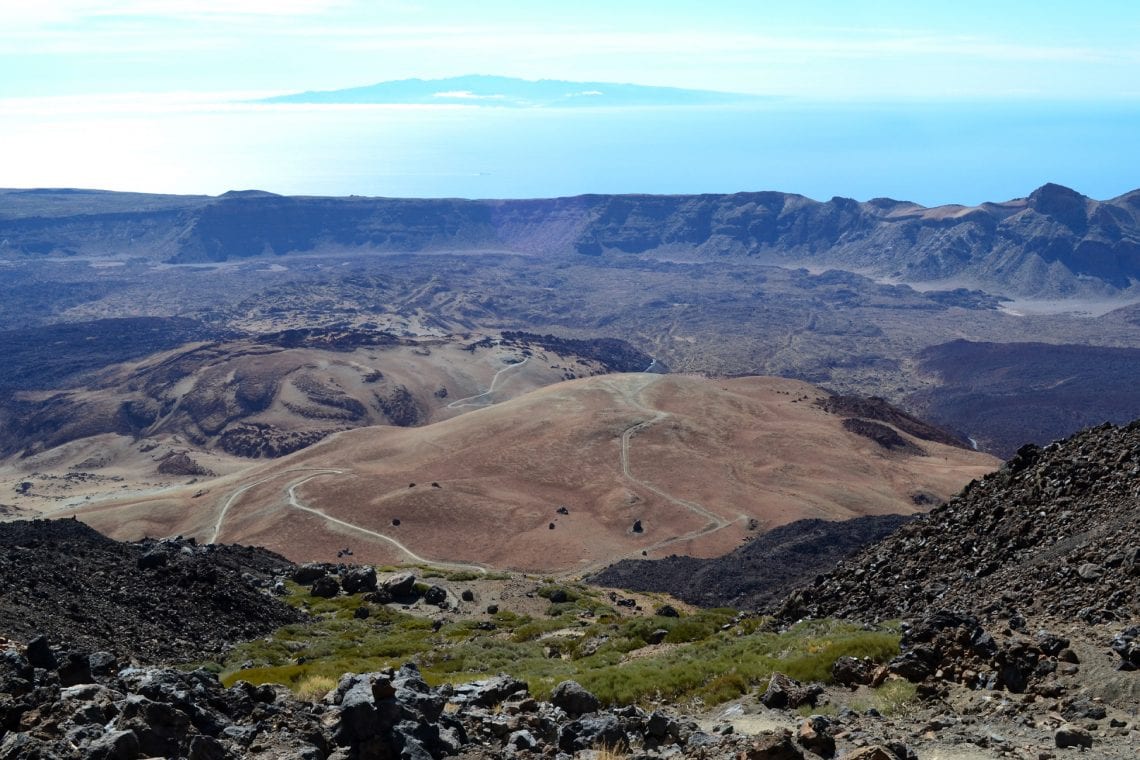
Above: Owen and Lee already above the clouds as they reach the steep sections where you can really see for miles
The refuge itself houses beds for climbers wanting to spend the night (20 euro) but during the day it’s locked down, and so are its toilet facilities – an extortionately expensive drink vending machine does remain accessible – the mind boggles on how they got that up there in the first place though! The views from the refuge are absolutely stunning as you look down. The initial gradual route along the Montana Blanca remains vaguely visible and triggers the back of your memory that it was just a couple of hours earlier, we and come from down there. What really catches the eye though is the Island of Gran Canaria that emerges form the deep blue sea. A stark contrast colours, and a perfect picture postcard moment is made here.
Straight past the refuge, the route will take you through a cooled lava flow; the narrow defined track takes you through the dark brown violently jaggered rocks and really gives you the feeling of what the earth is capable of if in a geologically foul mood. Shortness of breath worsens; headaches and even a mild confusion are experienced as our body struggles to replenish oxygen. Regular stops to catch our breath are made and by this point it’s fair to say all members of our group are experiencing some difficulties. Even a drink of water becomes hard work as after every sip comes the inevitable grasping for oxygen. A temporary relief of side effects takes place when we crack open a canister of 99% oxygen; an action which may seem a little bit dramatic, considering people have climbed Mount Everest without any supplemented oxygen, but then again this is nine unfit individuals that have never gone to such dizzy heights and any relief is good relief! Replenished, a new sigh of optimism sweeps across us. After a much longer than expected hike from the refuge, the summit falls into place and the viewing platform with the unmistakable top cable car station catch our attention. A few metres further and yet more switch backs we hit the ‘tourist trail’.
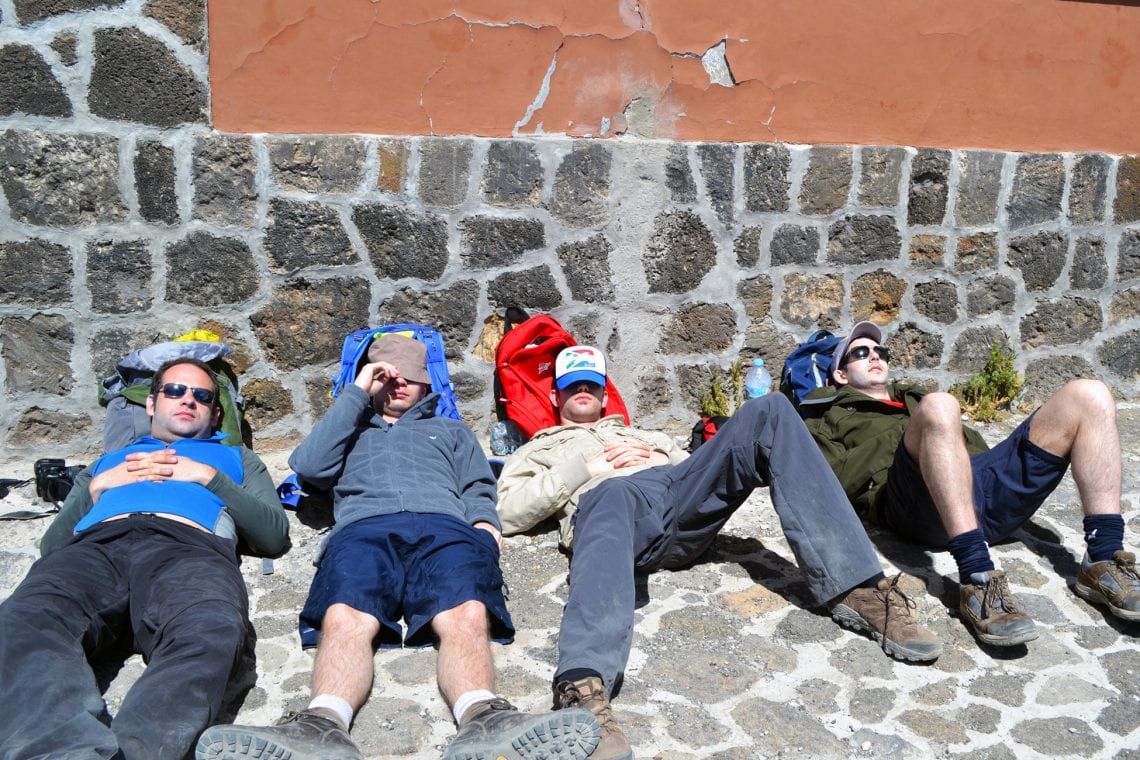
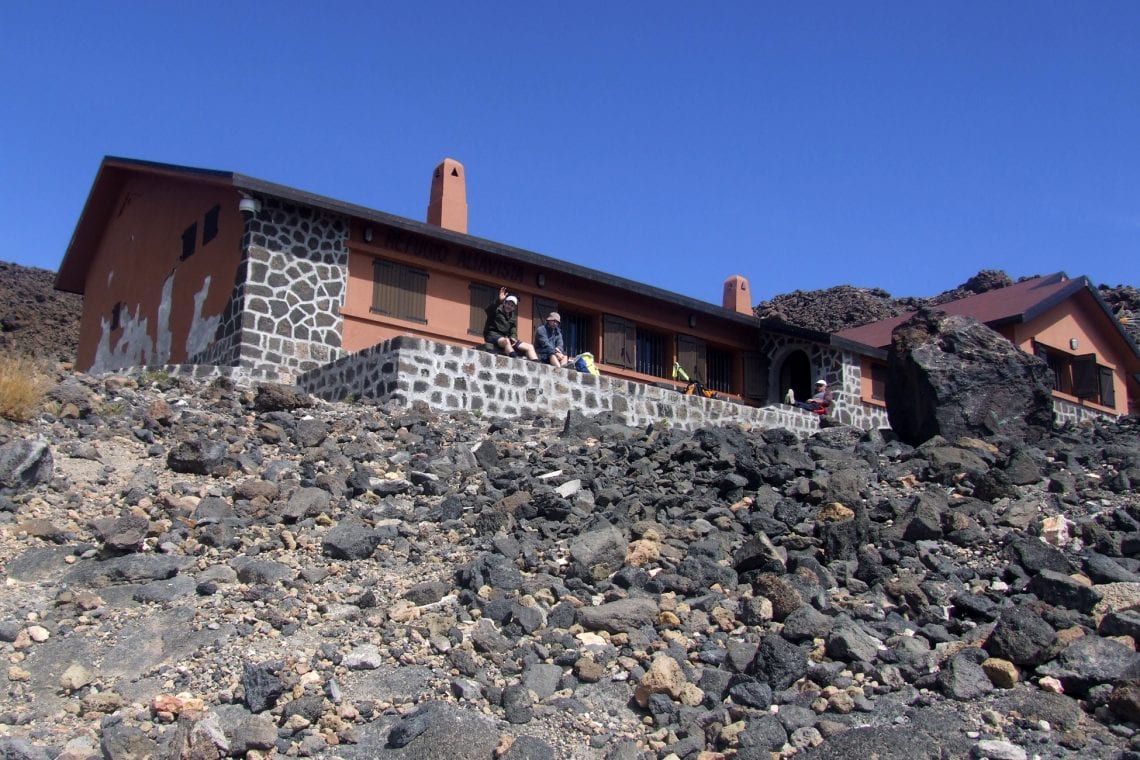
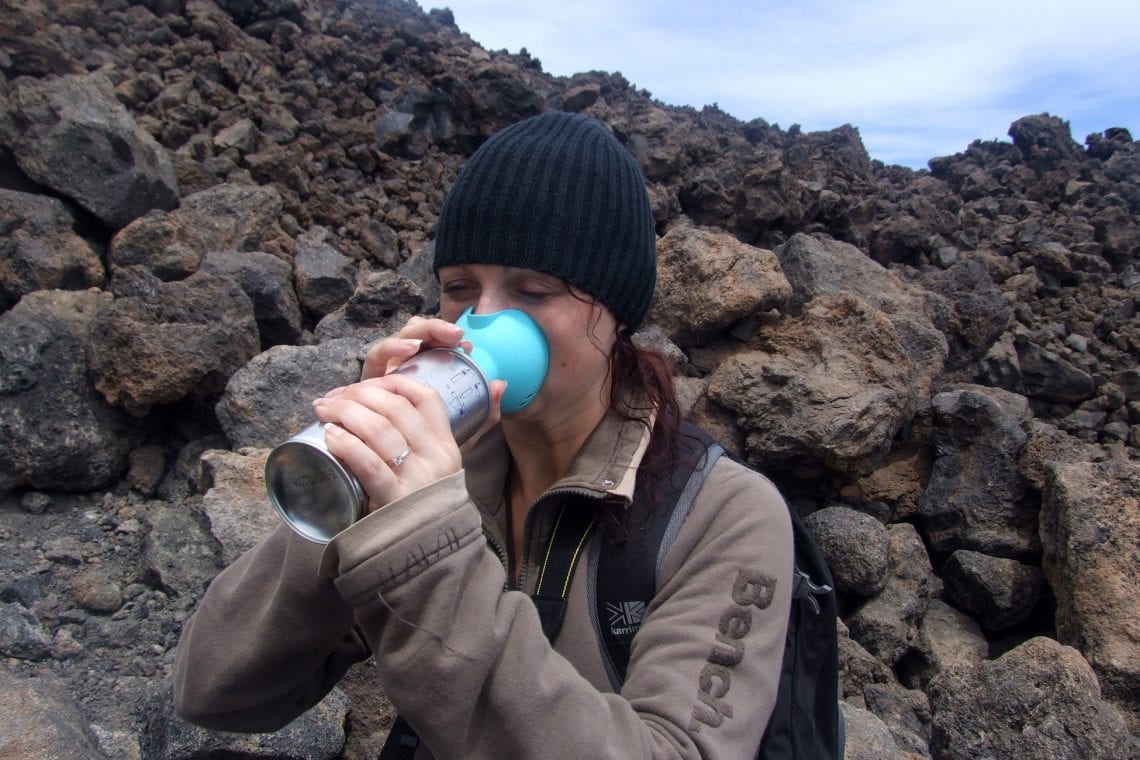
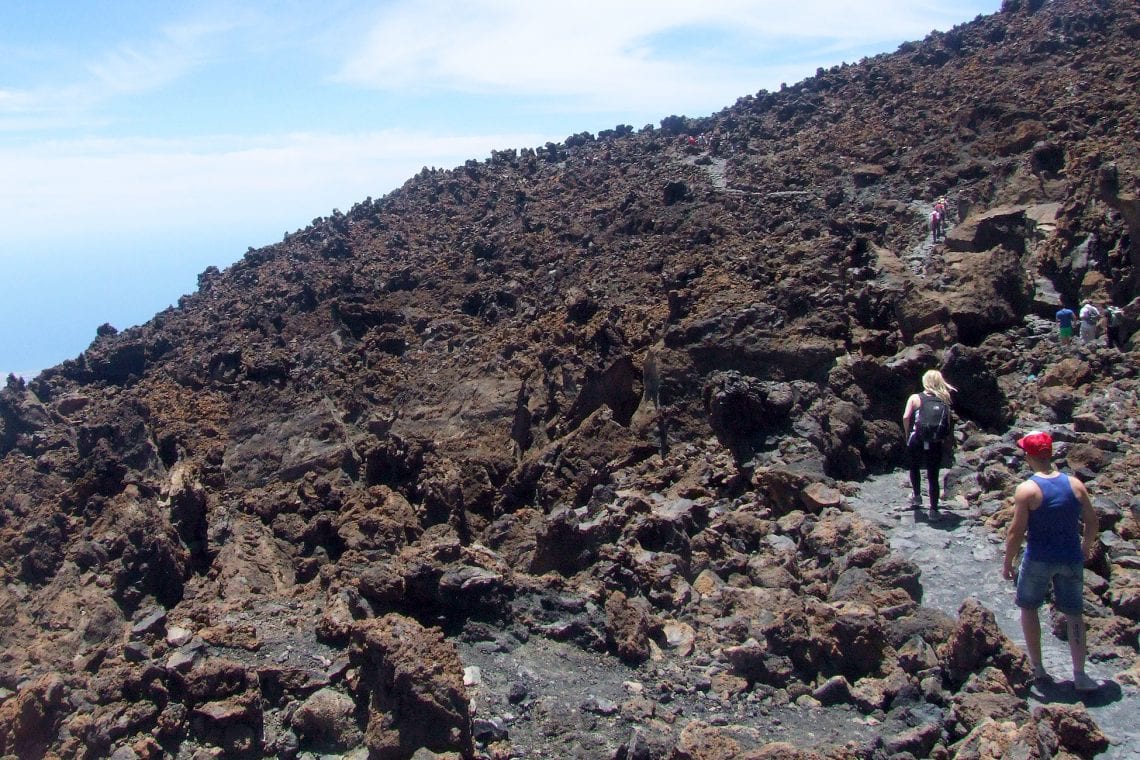
Above: Break time at the refuge | Emma climbing through the lava field and taking in a bit of oxygen
The solitude we’ve experienced on the way up is suddenly gone as the crowds of tourists from the cable car hop along the lava route in their flip flops without a worry or a stretched muscle. Perhaps it’s the exhaustion, perhaps the thin air, but my frustrations are projected as these visitors get in the way as I try to make way along route 7 to the final observation point by the cable car. I can’t help but feel that we’d earned these amazing views through hours of hiking and that everyone else had simply cheated and taken the easy route on the cable car. Rather than express my feeling and taint my experience, I suppressed them and carried out looking over the entire archipelago of the Canary Islands. The final few meters are on a rocky but horizontal path leading to the large cable car building; impossible to miss, looking very out of place. A toilet and running water are located here as is the tiny office with a hatch which allows those with a permit to persevere on to the main vent. Here park rangers inspect your permit and passport before they open a small wooden gate to the path leading up to the peak. The authorities cap daily visitor numbers, citing environmental protection, so many of the cable car tourists will not make it further. It’s not long before the solitude feeling returns, as we head closer to the crater, and higher in the atmosphere.

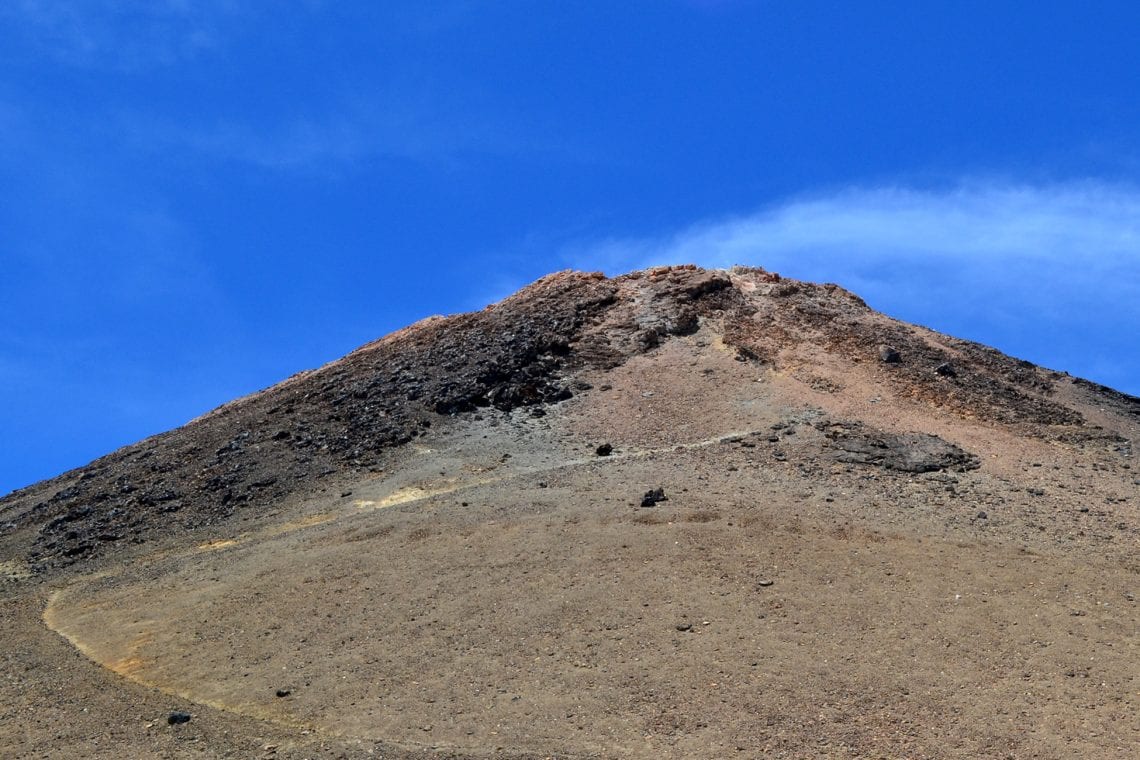
Above: The cable car station feels a tad out of place amidst the lava field | Most visitors don’t head to the main vent as a permit is required | The final vent is a steep strenuous climb

How to get the permit?
Some online sources and blogs state a permit is granted through small office somewhere on the island and that it’s difficult to find. This is no longer the case. The permit is free and available online through following link: www.reservasparquesnacionales.es. You will need to present you passport with the permit at the top.
The final few meters are on a rocky but horizontal path leading to the large cable car building; impossible to miss, looking very out of place. A toilet and running water are located here as is the tiny office with a hatch which allows those with a permit to persevere on to the main vent. Here park rangers inspect your permit and passport before they open a small wooden gate to the path leading up to the peak. The authorities cap daily visitor numbers, citing environmental protection, so many of the cable car tourists will not make it further. It’s not long before the solitude feeling returns, as we head closer to the crater, and higher in the atmosphere.
Though the final summit looks pretty daunting, it’s only about a further 25 minutes climb from the below viewing platform before we reach the crater at the top. Make shift steps along the way make for quick progress and the time we spent around the cable car and other people seem to have helped in our acclimatisation. Hot sulphurs gasses escaping through the rocks below our feet and along the main crater walls which we’re holding on to are the new challenges. Almost as steam bursts from a locomotive, the gas blows out from small cracks, never sure where they come from next we hastily move on along the rim of the main vent. The main crater itself is out of bounds and the strong concentrations of white gasses escaping from it are enough of a deterrent to stop you venturing into it.
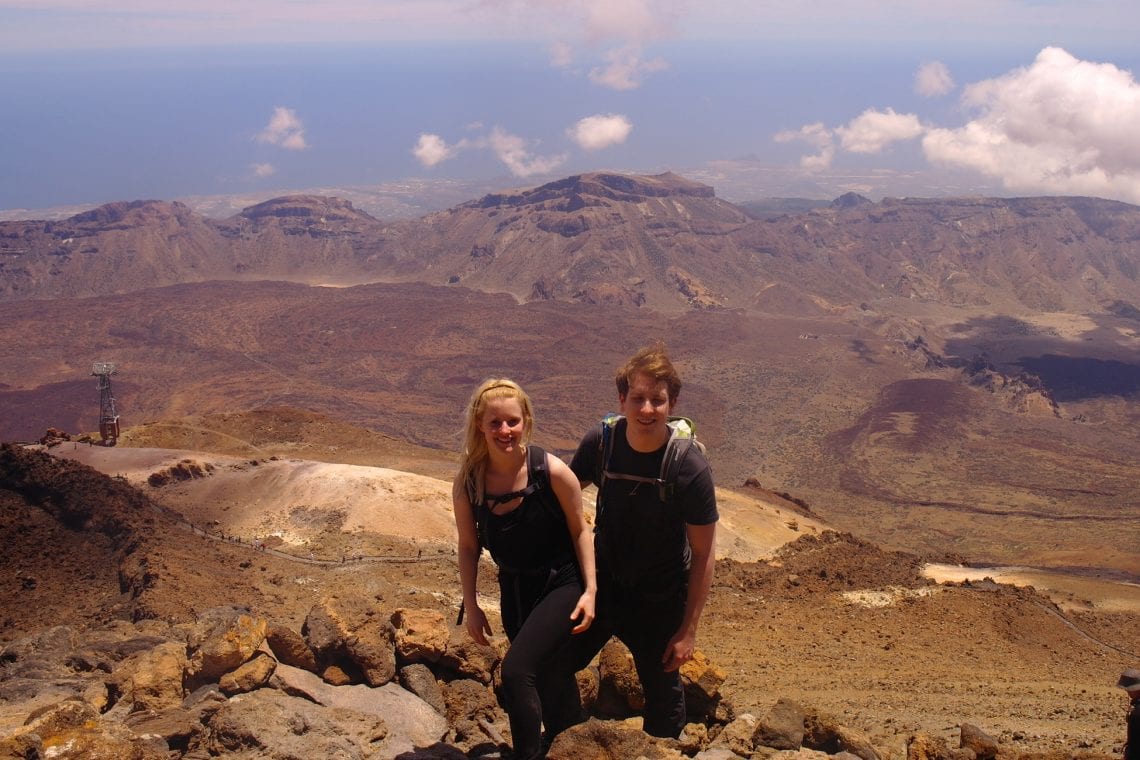

Above: The gang heading up to the main vent | Cable car’s run regularly back down
At the highest point of Spain and all the Atlantic Island your greeted by amazing views of much of Tenerife and a truly awesome sense of achievement. Along the horizon, a subtle curvature of the Earth’s surface is just about noticeable only to be broken by another island in the distance. Far in the distance the coastal resorts are visible as specks, it truly is as if you were looking down from an aeroplane window. A short break and the obligatory picture taking are soon over as this exhausting experience, unpleasant smells, coupled with the thin air, doesn’t really make you want to stick around too long. We make retrace our steps along the steep route back down to the cable car station where we buy our one way ticket (12.50 euro). The quick decent relieves any ill felt effects from the altitude and before you know it we’re at the base. A large car-park as well as café and souvenir shop is situated at the base of the cable car station, and a well-earned drink is a must. For those who chose to climb Teide it’s a further 2 km (30 minute walk) along the winding TF-21 road with no pedestrian footpath to the layby where the hike began. The route is described as difficult, not technically but physically. No doubt it’s the high altitude which brings ‘Route Number7’ into this category so before setting of, make sure you’ve read up on high altitude and any precautions. At times it may not seem so, but on reflection Teide is a really rewarding experience and well in the reach of any outdoor enthusiast.
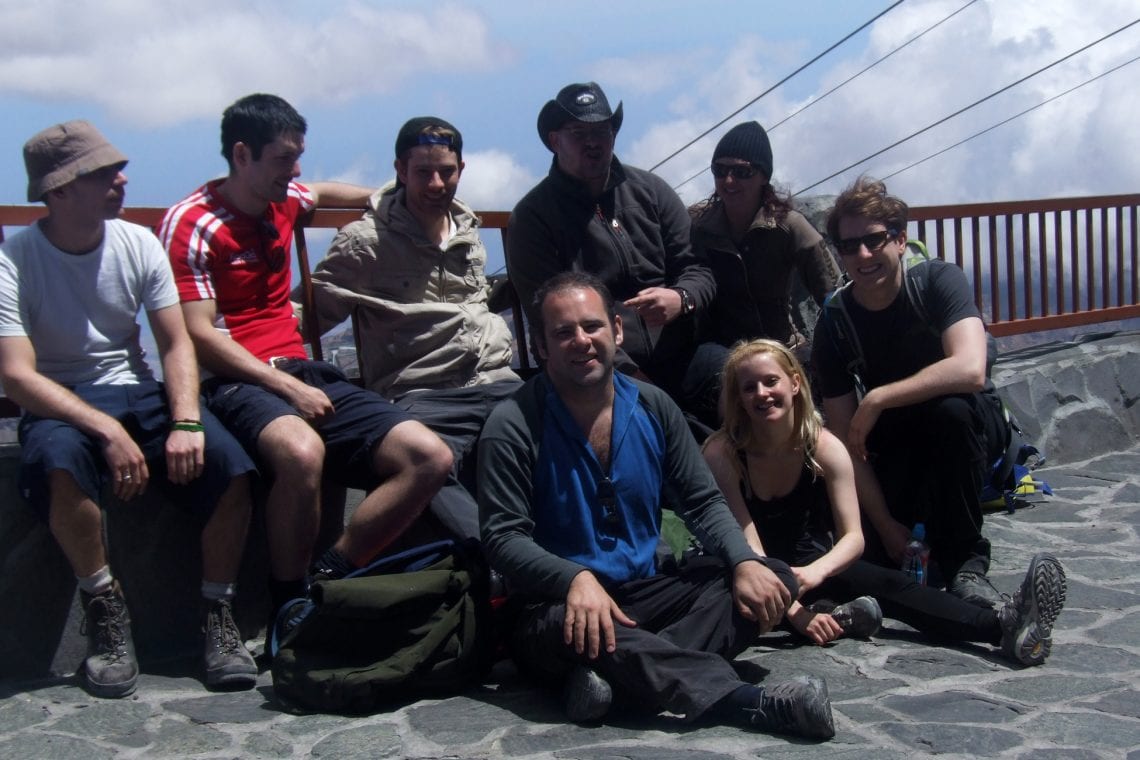
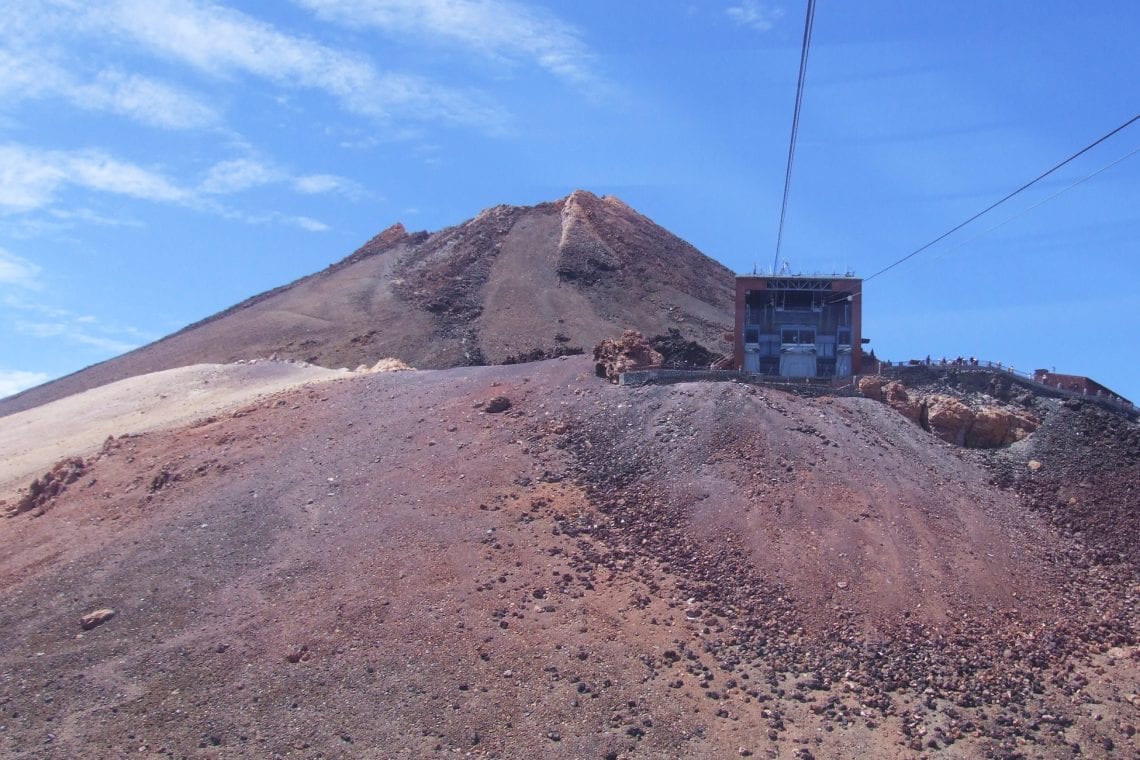
Above: Team photo before we head back down via the cable car
WHERE TO STAY
- We stayed at Hostel La Playain El Medano. Though it’s worth bearing in mind that a package holiday option can workout cost effective.
- There is also an option to stay on the volcano at Altavista del Teide Refuge
USEFUL LINKS
- Get your permit via this link: reservasparquesnacionales.es
- Teide national park website, with info on how to book the cable car: volcanoteide.com




